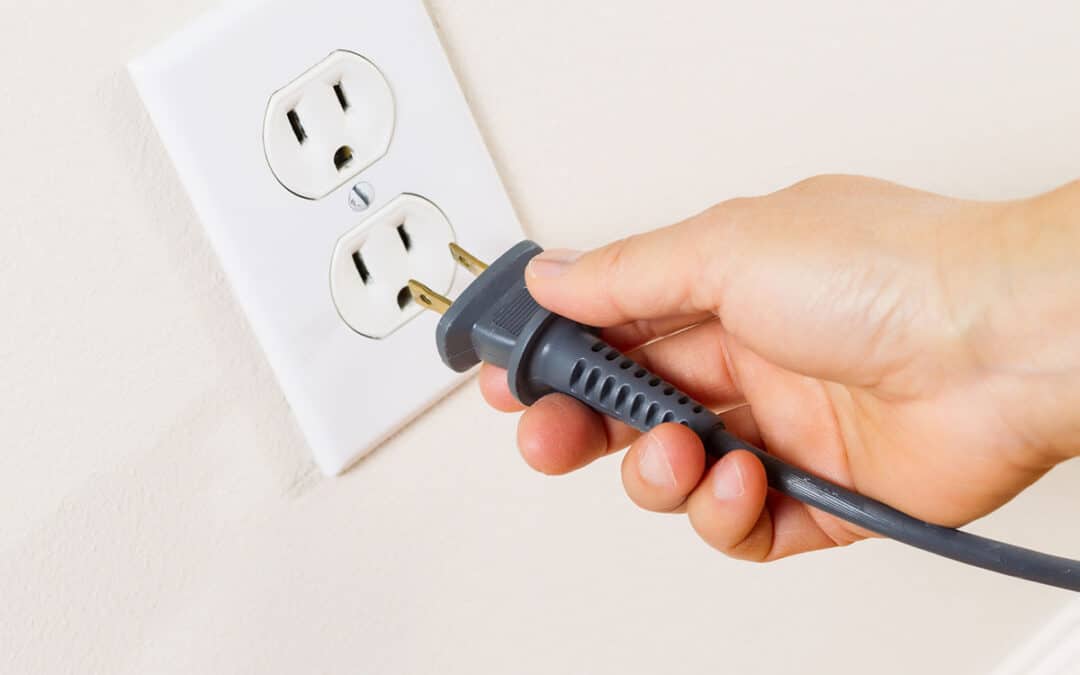If you encounter an outlet in your home that’s hot, it’s a sign to take a closer look at what could be going on. Because a hot outlet can indicate a possible fire hazard, investigating the cause and fixing the problem should be a top priority.
What are some common reasons for a hot outlet?
Outlet overload
It is possible that you are drawing too much energy from the outlet by having too many appliances plugged in. Unplug a few things and allow the outlet to cool down before using it again.
Circuit overload
While too much demand on an outlet may be overheating that one outlet, it’s also possible that you’re draining too much energy from the entire circuit. To remedy this, an electrician may need to rewire the circuits so there are fewer plugs per circuit.
Shorting circuit
A short circuit occurs when two wires touch. This will not only make your outlet hot to the touch, but it can be hot enough to leave scorch marks and melt surrounding plastics. The possibility of a fire is high with a shorting circuit and should be addressed immediately by a professional electrician.
Damaged or loose wires
As a home’s wiring ages, it’s possible for the wiring or the terminals inside an outlet to loosen or fray, allowing heat to build up due to the electricity flowing inside. Corrosion can cause the wires and electrical conductors to deteriorate and wear away, which raises the electrical resistance of the internal components and elevates the temperature.
Broken outlet
If you see any areas of the outlet that are chipped or broken, it’s a sign that the entire outlet may need to be replaced. You should also have the full electrical system checked for further signs of damage.
Moisture
If moisture gets into an outlet, overheating can occur because the electrical current is traveling places it shouldn’t and causing a short circuit.
Faulty installation
A poorly done repair or installation of an outlet can lead to insecure electrical connections, improper wiring or loose connections, resulting in a short circuit or a rise in the outlet’s electrical resistance.
What can we do about a hot outlet?
Fixing a hot electrical outlet begins with figuring out what’s causing the problem. An electrical outlet should never be hot, so it should be addressed immediately.
6 steps to take when you find a hot outlet
- Find the circuit breaker that controls the outlet and turn it off.
- Unplug everything from the hot outlet.
- Examine what was plugged in. Many devices such as cell phone chargers, cordless drills and printers use an internal transformer to change the voltage input. They can cause an outlet to become warm, though never too hot to touch. Unplug and wait for the outlet to return to normal temperature. Plug in a non-transformer-containing device to confirm that it was the device’s fault rather than a defective outlet.
- Investigate the possibility of an overloaded circuit. Most homes have circuits that are wired in a series, so the electrical current used by one outlet may also pass through many other outlets. An outlet may become warm due to overload, even if it only has one device plugged in or is not being used at all.
- If neither of the above seems to be the issue, assume it’s possible the outlet is worn out or broken and call an electrician.
- If you cannot contact an electrician right away and you’re concerned about a fire, contact the local fire department and ask them to check things out to be sure there’s no immediate risk.
How can we help?
At Shockley Electric, we address important home safety issues such as power surges, faulty electrical wiring and potential fire hazards when we do electrical preventive maintenance in homes or commercial buildings. We are licensed, trained, and skilled in safety-proofing your home, and we are committed to the safety and well-being of our customers.
If you are experiencing electrical problems in your home or aren’t sure if your home is protected from electrical hazards, schedule an in-home estimate or appointment with us today. Fill out our form or call us now for a free estimate!
You can also read our other blog post about how to test one of your home outlets.

